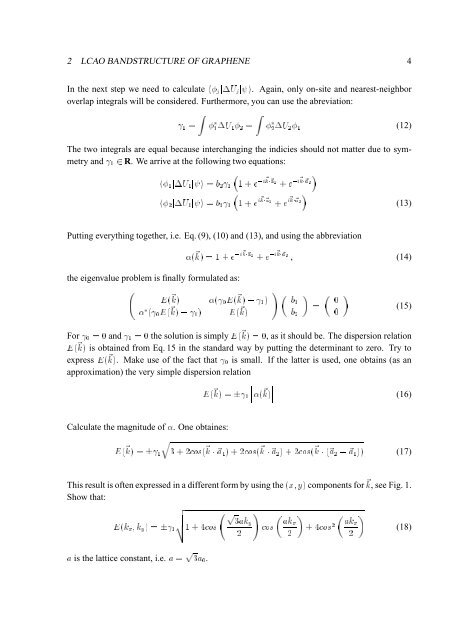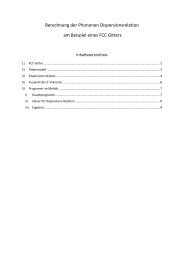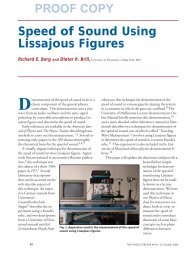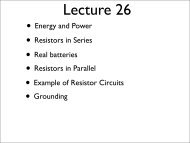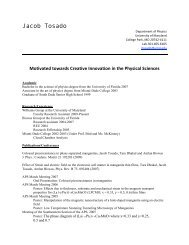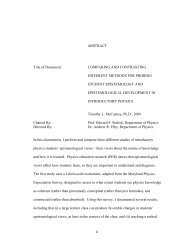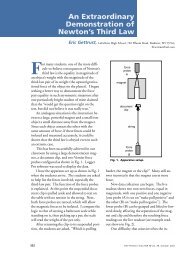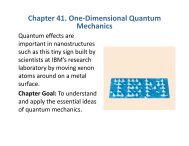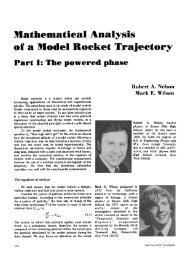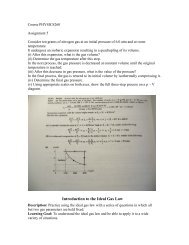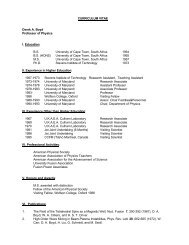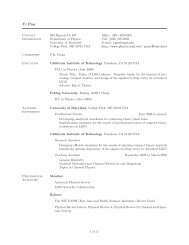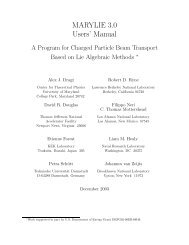Bandstructure of Graphene and Carbon Nanotubes: An ... - Physics
Bandstructure of Graphene and Carbon Nanotubes: An ... - Physics
Bandstructure of Graphene and Carbon Nanotubes: An ... - Physics
Create successful ePaper yourself
Turn your PDF publications into a flip-book with our unique Google optimized e-Paper software.
2 LCAO BANDSTRUCTURE OF GRAPHENE 4<br />
In the next step we need to calculate h jj Ujj i. Again, only on-site <strong>and</strong> nearest-neighbor<br />
overlap integrals will be considered. Furthermore, you can use the abreviation:<br />
1 =<br />
Z<br />
?<br />
1 U 1 2 =<br />
Z<br />
?<br />
2 U2 1 (12)<br />
The two integrals are equal because interchanging the indicies should not matter due to symmetry<br />
<strong>and</strong> 1 2 R. We arrive at the following two equations:<br />
h 1j U 1j i = b 2 1 1+e ,i~ k ~a1 + e ,i ~ k ~a2<br />
h 2j U 1j i = b 1 1 1+e i~ k ~a1 + e i ~ k ~a2 (13)<br />
Putting everything together, i.e. Eq. (9), (10) <strong>and</strong> (13), <strong>and</strong> using the abbreviation<br />
the eigenvalue problem is finally formulated as:<br />
( ~ k)=1+e ,i~k ~a1 + e ,i~k ~a2 , (14)<br />
E( ~ k) ( 0E( ~ k) , 1)<br />
? ( 0E( ~ k) , 1) E( ~ k)<br />
! b1<br />
For 0 =0<strong>and</strong> 1 =0the solution is simply E( ~ k)=0, as it should be. The dispersion relation<br />
E( ~ k) is obtained from Eq. 15 in the st<strong>and</strong>ard way by putting the determinant to zero. Try to<br />
express E( ~ k). Make use <strong>of</strong> the fact that 0 is small. If the latter is used, one obtains (as an<br />
approximation) the very simple dispersion relation<br />
b 2<br />
=<br />
0<br />
0<br />
(15)<br />
E( ~ k)= 1 ( ~ k) (16)<br />
Calculate the magnitude <strong>of</strong> . One obtaines:<br />
q<br />
3+2cos( ~ k ~a1) +2cos( ~ k ~a 2)+2cos( ~ k (~a 2 , ~a 1)) (17)<br />
E( ~ k)= 1<br />
This result is <strong>of</strong>ten expressed in a different form by using the (x; y) components for ~ k, see Fig. 1.<br />
Show that:<br />
vu<br />
u<br />
E(kx;ky) = t 1 1+4cos<br />
p<br />
a is the lattice constant, i.e. a = 3a0.<br />
p 3aky<br />
2<br />
!<br />
cos akx<br />
2<br />
+4cos 2<br />
akx<br />
2<br />
(18)


